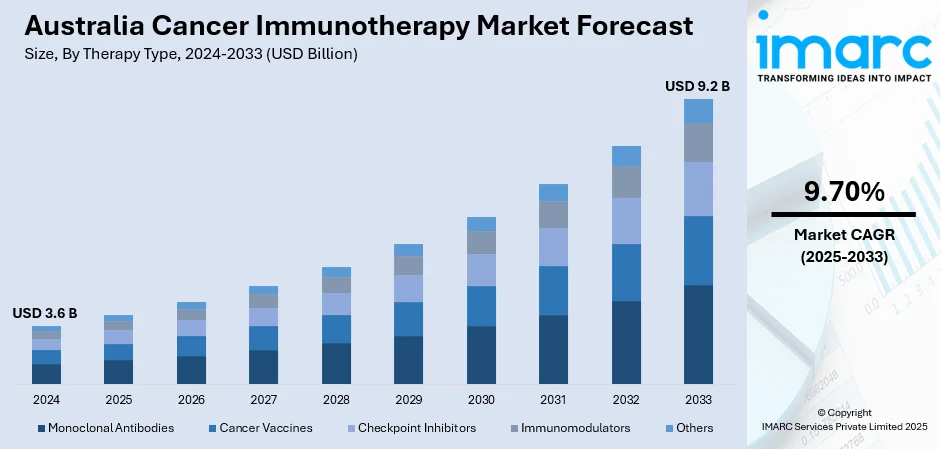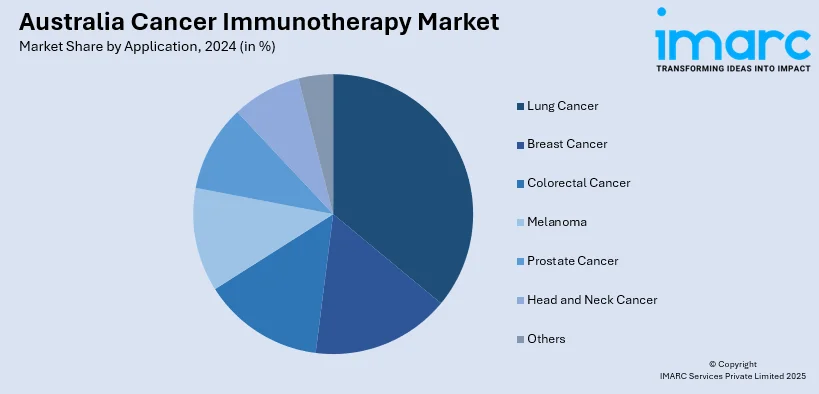
Australia Cancer Immunotherapy Market Size, Share, Trends and Forecast by Therapy Type, Application, End User, and Region, 2025-2033
Australia Cancer Immunotherapy Market Overview:
The Australia cancer immunotherapy market size reached USD 3.6 Billion in 2024. Looking forward, IMARC Group expects the market to reach USD 9.2 Billion by 2033, exhibiting a growth rate (CAGR) of 9.70% during 2025-2033. The market is propelling by innovation in immunological science and growing adoption of targeted therapies in oncology treatment strategies. The mounting cancer burden, along with advanced diagnostic technologies and growing clinical trial activity, is driving widespread acceptance of new immunotherapeutic modalities. Favorable regulatory environments and investments in healthcare technology are also driving the development of the market. These synergistic forces are driving the expanding Australia cancer immunotherapy market share.
|
Report Attribute
|
Key Statistics
|
|---|---|
|
Base Year
|
2024
|
|
Forecast Years
|
2025-2033
|
|
Historical Years
|
2019-2024
|
| Market Size in 2024 | USD 3.6 Billion |
| Market Forecast in 2033 | USD 9.2 Billion |
| Market Growth Rate 2025-2033 | 9.70% |
Australia Cancer Immunotherapy Market Trends:
Increase in Targeted and Combination Therapies Adoption
The rising use of targeted and combination immunotherapies is transforming the landscape of Australia cancer treatment. These treatments aim to target cancer cells selectively and spare healthy tissues, leading to better patient outcomes and fewer side effects. The combination of immune checkpoint inhibitors and targeted molecules has proved to be more effective, especially in the treatment of resistant or advanced cancers. This movement is indicative of a shift to precision oncology, wherein treatments are individualized on the basis of genetic and molecular tumor characteristics. Australia's oncology community has welcomed this innovation through the support of changing clinical protocols and increased diagnostic capabilities. Patient availability to the latest therapies is accelerating with more clinicians following these regimens in both urban and regional regions. Australia cancer immunotherapy growth is thus also being strongly fueled by this clinical shift, with anticipated further uptrend momentum in demand and investment in research in the years ahead, further solidifying the sector's status as a pillar of contemporary cancer treatment.

To get more information on this market, Request Sample
Rising Emphasis on Cancer Immunotherapy for Solid Tumors
A sharpened emphasis on the use of immunotherapy for the treatment of solid tumors is a hallmark trend in Australia's changing oncology environment. Advances in immune checkpoint inhibitors and tumor-specific antigens have made it possible to produce significant clinical responses in cancers that were previously not responsive to conventional treatments, including lung, colorectal, and head and neck cancers. According to the reports, in December 2023, Peter MacCallum Cancer Centre was awarded a \\$5M NHMRC Synergy Grant to progress CAR T-cell therapy for prostate cancer, with a focus on overcoming the difficulties of treating solid tumors. Moreover, Australian researchers and clinicians are intensely looking to target the tumor microenvironment to augment immune responses and circumvent immunosuppressive strategies. Such strategy is bolstered by cutting-edge imaging modalities and biomarker assessments that enable improved patient selection and monitoring. Active clinical trials in key medical centers are testing new combinations and sequences of therapies in a broad spectrum of tumor types. Such an upsurge in innovation is playing its part in the Australia cancer immunotherapy share as increased numbers of patients are being made eligible for life-changing treatment. With strong institutional backing and vigorous academic interest, solid tumor immunotherapy is likely to be one of the country's leading growth drivers of the nation's oncological treatment strategy.
Growth of Research and Development Activities
Australia has become a leading center for cancer immunotherapy research and development backed by a mature clinical infrastructure and exposure to a heterogenous population of patients. Rising government grants, collaborations with international research centers, and investment from academic bodies have fostered an innovative ecosystem. Local research is investigating new-generation therapies, such as neoantigen vaccines, adoptive cell therapies, and bispecific antibodies. As per the reports, in December 2023, BioNTech partnered with the State of Victoria through a multi-year agreement to open an mRNA production facility and innovation center in Melbourne, further developing cancer treatment development. Furthermore, focus is also being put on non-invasive diagnostics and treatment monitoring in real time, which are likely to enhance outcomes and lower the cost of healthcare. These developments are facilitated by national clinical trial networks and collaborative research groups that make patient enrollment more efficient and analysis of data faster. Success of this research and development (R&D) driven strategy is evident from an increasing number of immunotherapy candidates in the early- and late-stage phases advancing to regulatory tracks. As these treatments move towards approval, Australia cancer immunotherapy market outlook is positive, driven by scientific advances and a focus on international competitiveness in oncology innovation.
Australia Cancer Immunotherapy Market Segmentation:
IMARC Group provides an analysis of the key trends in each segment of the market, along with forecasts at the country and regional levels for 2025-2033. Our report has categorized the market based on therapy type, application, and end user.
Therapy Type Insights:
- Monoclonal Antibodies
- Cancer Vaccines
- Checkpoint Inhibitors
- Immunomodulators
- Others
The report has provided a detailed breakup and analysis of the market based on the therapy type. This includes monoclonal antibodies, cancer vaccines, checkpoint inhibitors, immunomodulators, and others.
Application Insights:

- Lung Cancer
- Breast Cancer
- Colorectal Cancer
- Melanoma
- Prostate Cancer
- Head and Neck Cancer
- Others
A detailed breakup and analysis of the market based on the application have also been provided in the report. This includes lung cancer, breast cancer, colorectal cancer, melanoma, prostate cancer, head and neck cancer, and others.
End User Insights:
- Hospitals
- Cancer Research Centers
- Clinics
- Others
The report has provided a detailed breakup and analysis of the market based on the end user. This includes hospitals, cancer research centers, clinics, and others.
Regional Insights:
- Australia Capital Territory & New South Wales
- Victoria & Tasmania
- Queensland
- Northern Territory & Southern Australia
- Western Australia
The report has also provided a comprehensive analysis of all the major regional markets, which include Australia Capital Territory & New South Wales, Victoria & Tasmania, Queensland, Northern Territory & Southern Australia, and Western Australia.
Competitive Landscape:
The market research report has also provided a comprehensive analysis of the competitive landscape. Competitive analysis such as market structure, key player positioning, top winning strategies, competitive dashboard, and company evaluation quadrant has been covered in the report. Also, detailed profiles of all major companies have been provided.
Australia Cancer Immunotherapy Market News:
- In January 2025, Kazia Therapeutics initiated the ABC-Pax trial evaluating paxalisib with immunotherapy to treat advanced breast cancer. The novel study focuses on triple-negative breast cancer, testing the safety and efficacy of paxalisib with KEYTRUDA® or LYNPARZA®. The trial represents a pioneering method to treat aggressive breast cancer.
Australia Cancer Immunotherapy Market Report Coverage:
| Report Features | Details |
|---|---|
| Base Year of the Analysis | 2024 |
| Historical Period | 2019-2024 |
| Forecast Period | 2025-2033 |
| Units | Billion USD |
| Scope of the Report |
Exploration of Historical Trends and Market Outlook, Industry Catalysts and Challenges, Segment-Wise Historical and Future Market Assessment:
|
| Therapy Types Covered | Monoclonal Antibodies, Cancer Vaccines, Checkpoint Inhibitors, Immunomodulators, Others |
| Applications Covered | Lung Cancer, Breast Cancer, Colorectal Cancer, Melanoma, Prostate Cancer, Head and Neck Cancer, Others |
| End Users Covered | Hospitals, Cancer Research Centers, Clinics, Others |
| Regions Covered | Australia Capital Territory & New South Wales, Victoria & Tasmania, Queensland, Northern Territory & Southern Australia, Western Australia |
| Customization Scope | 10% Free Customization |
| Post-Sale Analyst Support | 10-12 Weeks |
| Delivery Format | PDF and Excel through Email (We can also provide the editable version of the report in PPT/Word format on special request) |
Key Questions Answered in This Report:
- How has the Australia cancer immunotherapy market performed so far and how will it perform in the coming years?
- What is the breakup of the Australia cancer immunotherapy market on the basis of therapy type?
- What is the breakup of the Australia cancer immunotherapy market on the basis of application?
- What is the breakup of the Australia cancer immunotherapy market on the basis of end user?
- What is the breakup of the Australia cancer immunotherapy market on the basis of region?
- What are the various stages in the value chain of the Australia cancer immunotherapy market?
- What are the key driving factors and challenges in the Australia cancer immunotherapy?
- What is the structure of the Australia cancer immunotherapy market and who are the key players?
- What is the degree of competition in the Australia cancer immunotherapy market?
Key Benefits for Stakeholders:
- IMARC’s industry report offers a comprehensive quantitative analysis of various market segments, historical and current market trends, market forecasts, and dynamics of the Australia cancer immunotherapy market from 2019-2033.
- The research report provides the latest information on the market drivers, challenges, and opportunities in the Australia cancer immunotherapy market.
- Porter's five forces analysis assist stakeholders in assessing the impact of new entrants, competitive rivalry, supplier power, buyer power, and the threat of substitution. It helps stakeholders to analyze the level of competition within the Australia cancer immunotherapy industry and its attractiveness.
- Competitive landscape allows stakeholders to understand their competitive environment and provides an insight into the current positions of key players in the market.
Need more help?
- Speak to our experienced analysts for insights on the current market scenarios.
- Include additional segments and countries to customize the report as per your requirement.
- Gain an unparalleled competitive advantage in your domain by understanding how to utilize the report and positively impacting your operations and revenue.
- For further assistance, please connect with our analysts.
 Request Customization
Request Customization
 Speak to an Analyst
Speak to an Analyst
 Request Brochure
Request Brochure
 Inquire Before Buying
Inquire Before Buying




.webp)




.webp)












